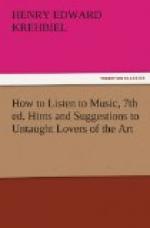[Sidenote: The bond between the movements.]
The most significant of the compositions of this period are the Suites, which because they make up so large a percentage of Clavier literature (using the term to cover the pianoforte and its predecessors), and because they pointed the way to the distinguishing form of the subsequent period, the sonata, are deserving of more extended consideration. The suite is a set of pieces in the same key, but contrasted in character, based upon certain admired dance-forms. Originally it was a set of dances and nothing more, but in the hands of the composers the dances underwent many modifications, some of them to the obvious detriment of their national or other distinguishing characteristics. The suite came into fashion about the middle of the seventeenth century and was also called Sonata da Camera and Balletto in Italy, and, later, Partita in France. In its fundamental form it embraced four movements: I. Allemande. II. Courante. III. Sarabande. IV. Gigue. To these four were sometimes added other dances—the Gavotte, Passepied, Branle, Minuet, Bourree, etc.—but the rule was that they should be introduced between the Sarabande and the Gigue. Sometimes also the set was introduced by a Prelude or an Overture. Identity of key was the only external tie between the various members of the suite, but the composers sought to establish an artistic unity by elaborating the sentiments for which the dance-forms seemed to offer a vehicle, and presenting them in agreeable contrast, besides enriching the primitive structure with new material. The suites of Bach and Handel are the high-water mark in this style of composition, but it would be difficult to find the original characteristics of the dances in their settings. It must suffice us briefly to indicate the characteristics of the principal forms.
[Sidenote: The Allemande.]
The Allemande, as its name indicates, was a dance of supposedly German origin. For that reason the German composers, when it came to them from France, where the suite had its origin, treated it with great partiality. It is in moderate tempo, common time, and made up of two periods of eight measures, both of which are repeated. It begins with an upbeat, and its metre, to use the terms of prosody, is iambic. The following specimen from Mersenne’s “Harmonie Universelle,” 1636, well displays its characteristics:
[Music illustration]
[Sidenote: Iambics in music and poetry.]
Robert Burns’s familiar iambics,
“Ye flowery banks o’
bonnie Doon,
How can ye bloom
sae fair?
How can ye chant, ye little
birds,
And I sae fu’
o’ care!”
might serve to keep the rhythmical characteristics of the Allemande in mind were it not for the arbitrary changes made by the composers already hinted at. As it is, we frequently find the stately movement of the old dance broken up into elaborate, but always quietly flowing, ornamentation, as indicated in the following excerpt from the third of Bach’s English suites:




